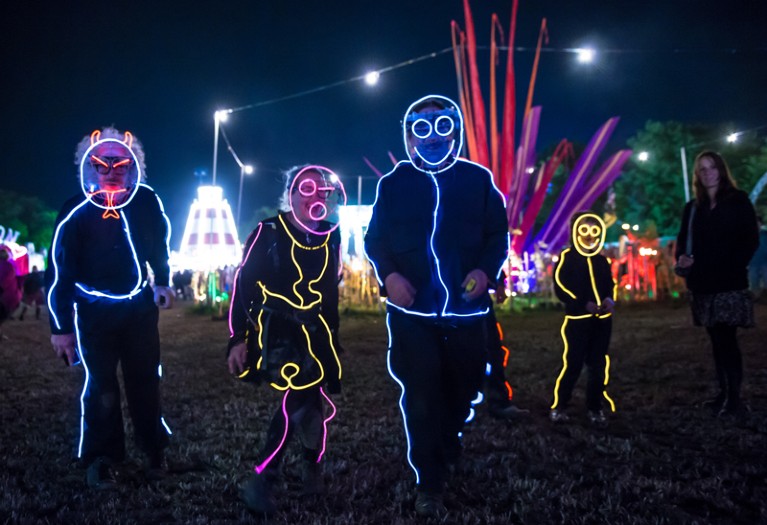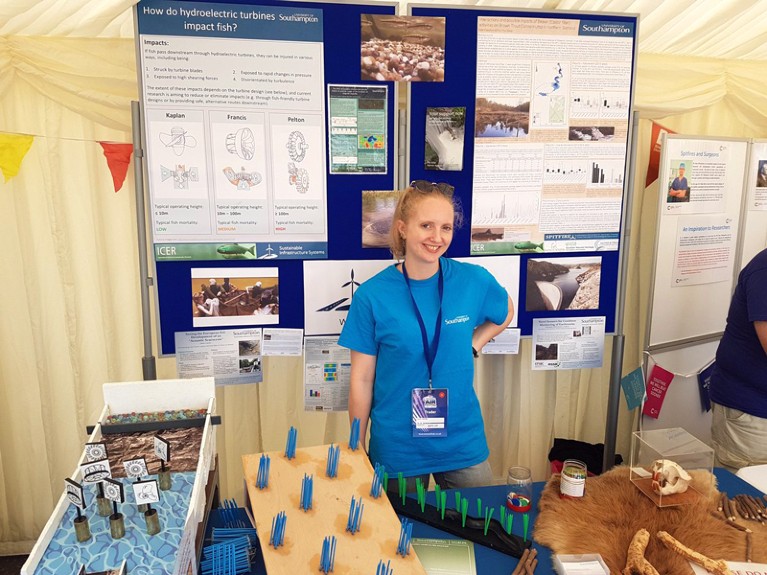
Neon-clad festival-goers enjoy the scene at Glastonbury. Festivals are a place to celebrate not only music and art — but also science.Credit: Ian Gavan/Getty
In February 2017, Helen Currie joined a team of researchers on a tour of UK festivals to share the impact of her research with people outside her field. Currie studies how sound affects migratory-fish behaviour, and is in the fourth year of a doctoral programme at the University of Southampton, UK.
How did you break into science communication?
Some of the events I took part in during the first year of my PhD lacked the impact I was hoping for. When we just set up under a gazebo in a park with a poster, nobody stopped to talk to us, which was discouraging. At an ecology festival in Southampton, however, my team and I found our groove. We received feedback from environment-conscious visitors who thought that our research into how dams, weirs and other structures can damage migratory-fish ecosystems would have a real impact on assisting the development of river infrastructure that is more sustainable.
How do you engage people with your research?
After our first few events, we learnt that our activities needed to be hands-on and interactive, so with the help of others at the University of Southampton, we created a marble run consisting of a custom-built sloped structure on which people place several marbles. These roll down past a series of barriers, such as gates, gaps, side channels and plastic pins. The marbles represent fish, and the run itself is a river, with barriers representing things that are dangerous to the fish, such as hydropower turbines or locations where water is purposely removed from the river to control flooding or for irrigation use. Participants can alter the river system to make it more friendly or hostile for the fish. We challenge participants to get as many fish through the marble run as possible while we explain our research.
We then joined our university’s public-engagement ‘roadshow’. This is an ongoing project that encourages researchers to share their work with the public. Every summer, the roadshow travels to several events in the United Kingdom, including music festivals.
Which music festivals have you attended?
The biggest one was Glastonbury Festival 2017, a five-day event that drew 135,000 attendees. For the past few years, festival organizers have invited UK universities to showcase some of their research in the science tent. Our team shared the tent with a number of other universities. I also presented my work at the Green Man, an arts festival in Crickhowell, Wales, which welcomes researchers and universities to apply for a space in a dedicated science area.

Helen Currie showcases her migratory-fish research at a UK festival to spread awareness to the public.Credit: Gerardo Espindola Garcia
What is it like to be a science presenter at these events?
It can be logistically challenging because you’re in a field, not a building. You really need to think about what activity you’re bringing with you. How heavy is it? Do you need a power source? But it’s also great fun. All the presenters at Glastonbury had prepared a key message about their project to share with visitors that was simple enough for any other presenters to take over and explain. So if we wanted to see a band play, we could briefly hand over responsibility to another presenter and experience some of the festival for ourselves. There were a number of great bands there that year, but my favourite was Royal Blood.
Are people surprised to find science at a music festival?
People these days tend to expect more than just music. Glastonbury has comedy, poetry readings and art installations, so a science tent fits in well. People come to get an experience, and learning just happens to be a secondary outcome. And science probably isn’t the strangest thing you will find at a music festival. A couple of people did ask us why we were there, so we explained what we did and the importance of giving back. A lot of public funding goes into science research. It’s good to get out and tell people what their taxes are being spent on and why.
Who visits the science area?
It’s so varied. Some people hear there’s a science tent and actively seek it out. Others wander around the festival and just come across it. There is a wide range of ages as well, from families with young kids to groups of friends, older couples and lone travellers.
How do you switch your message between these different visitors?
People will tell you when they know more about your topic. Even when talking to kids, you’d be surprised what they’re already aware of. But you don’t want to pitch too high and risk confusing or boring someone, so it’s best to start lower and increase the level as the conversation goes. You can have really long conversations this way. Sometimes I walked away having learnt something myself. For example, a fisher I was speaking to referred to a three-spined stickleback fish as a ‘bramstickle’, a term I had never heard before. I have since found out that in the British Isles, there are at least 70 different dialectical terms for the same species of fish.
What have you learnt about science communication from your festival experience?
It really helped me to see the big picture of my research. I think we sometimes get caught up in the ‘nicheness’ of what we do, but talking to people at music festivals really helped me to break it back down to the key research question.
What is your advice to colleagues who want to share their research at a similar event?
Just give it a go. You get so much out of it in terms of feedback from people. It makes you realize that you’re having an impact, and the conversations you have with people make you think about your research in a different way. So if you have the opportunity, get involved.









